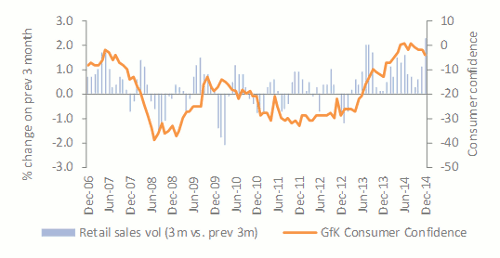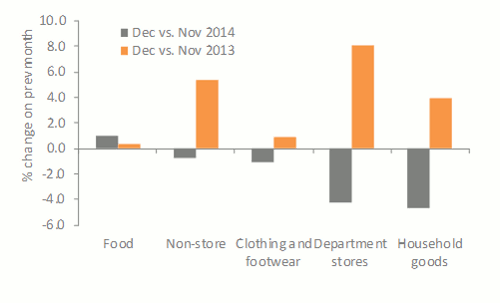Summary: UK Retail Sales - December 2014
The latest data from the ONS suggests that the consumer recovery remained robust in the final quarter of 2014 and looking ahead, the prospects for 2015 appear encouraging. Retail sales in the final quarter grew at the fastest rate in 12 years with sales volumes up 2.3% compared with the previous quarter (see chart 1 below).
Chart 1: Retail Sales Volumes (3m on 3m) and consumer confidence  Source: ONS, GfK
Source: ONS, GfK However, analysing December’s figures in isolation paints a slightly misleading picture due to the distorting impact “Black Friday” had on the timing of spending. Both the ONS and BRC surveys suggest that some Christmas spending, which traditionally would have occurred in December, had been brought forward to take advantage of Black Friday in November.
Chart 2: Retail Sales growth December vs. November 2014 & 2013  Source: ONS
Source: ONS Comparing the performance of sales growth between November and December in 2014 versus 2013 confirms the shift in spending.Chart 2 shows the significant drop off in sales in 2014 as spending was bought forward compared with 2013 when there was strong sales growth from November to December. However, it appears that not only did people bring forward spending but they actually spent more during the three months to December. As a result, ONS retail sales in December were up by 2.5% (value, non-seasonally adjusted), considerably weaker than November (+5.4%), but robust given the forward shift in spending. Many analysts were expecting much weaker growth, especially as the comparison was against a period last year which included Black Friday, according to the ONS calendar. This differed from the BRC which reported its weakest level of growth for December since 2008. But, December’s total sales of +1.0% does not point towards a collapse in sales, but rather a distortion that will need to be accounted for in Christmas sales periods to come. In fact, if you take October, November and December together, annual sales growth was c.1.5% up on the same three month period of the previous year which makes trading stronger, especially if you considering the drag that food sales and deflation have had over this period.This approach gives a much more rounded indication of performance for the Christmas period. So all in all, non-food sales are likely to have performed better than at first glance, however, any deep discounting from Black Friday would have eroded margins. It is also important to consider the impact of retail price deflation over this period which has dampened top line growth for values. The ONS retail sales deflator, an indication of retail inflation, fell by an annual 2.2% - the largest fall in prices since June 2002. Overall, the outlook for 2015 looks positive with inflation low, real earnings rising and confidence at relatively high levels. The prospect of a rise in interest rates has been pushed back 2016 and so we expect robust growth in earnings and, hence, consumer spending. The dark cloud of the General Election, due to take place in May 2015, continues to loom but underlying macroeconomic conditions look conducive to robust retail growth this year.
Back to Retail Economic News